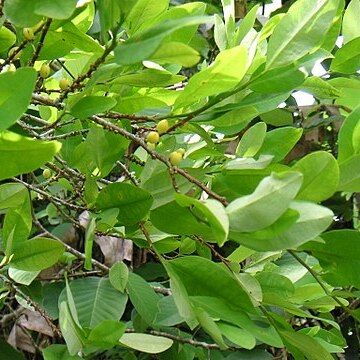Trees, shrubs or subshrubs, glabrous. Leaves alternate or rarely opposite, simple, entire, pinnately nerved; stipules ± united, intrapetiolar or rarely interpetiolar. Flowers axillary, solitary, in fascicles or rarely in pedunculate inflorescences, regular, hermaphrodite or unisexual, heterostylous. Sepals (4–)5, valvate, ± united. Petals (4–)5, with contorted aestivation, free, clawed, soon falling, usually with a ligulate nectariferous appendage inside. Stamens 10, all fertile, the filaments united at the base to form a shallow or urn-shaped cup, sometimes glandular; anthers basifixed, dehiscing longitudinally. Ovary superior, 2–3(–4)-locular, the locules with 1 or rarely 2 pendulous ovules; styles 2–3(–4), free or ± united, with club-shaped, capitate or rarely acute stigmas. Fruit a 1-seeded fleshy drupe or rarely a 3(–4)-locular, 3(–4)-seeded capsule dehiscing longitudinally. Seeds with no aril and no or very little endosperm; embryo straight with flat or semiconvex cotyledons
Shrubs or trees. Stipules intrapetiolar. Leaves alternate or rarely opposite, simple; leaf blade margin entire. Flowers usually bisexual, in axillary fascicles or cymes, regular, 5-merous, often heterostylous. Sepals 5, basally connate, with imbricate or valvate lobes, persistent. Petals 5, distinct, imbricate, usually with a scale on inner face at base. Stamens 5, 10, or 20, 1-or 2-verticillate; filament bases usually connate into a tube; anthers elliptic, 2-celled, with longitudinal slits. Ovary superior, connected with 3-5 carpels, 3-5-locular, with 1(or 2) axile; ovules pendulous, anatropous to hemitropous, placentation axile; styles 1-3 or 5, distinct or somewhat connate; stigmas oblique. Fruit a capsule or a 1-seeded drupe. Seeds with straight embryo and copious (rarely absent) endosperm.
Ovary superior, 2–3 (4)-locular, with each loculus 1-ovulate (or rarely 2-ovulate); ovules pendulous; styles 2–3 (4), free or ± united, with stigmas clavate to obliquely capitate or depressed-capitate rarely acute
Ovary of 3 carpels, 3-celled, mostly two of the cells sterile, fertile cells 1–2-ovuled; ovules pendulous; styles 3, free or more or less connate; stigmas oblique, depressed-capitate or clavate
Stamens 5 + 5, all fertile, with filaments united at the base to form a deep urceole or shallow rarely glandiferous cup; anthers basifixed, dehiscing longitudinally
Leaves alternate (or rarely opposite), simple, entire, penninerved, with stipules ± united and intrapetiolar (or rarely interpetiolar)
Flowers axillary, solitary or in fascicles (rarely pedunculate), actinomorphic, bisexual or rarely subdioecious, heterostylic
Seeds not compressed, exarillate, without or with scanty endosperm; embryo straight, with flat or semiconvex cotyledons
Petals (4) 5, contorted in bud, free, unguiculate, caducous, usually with a ventral ligule-like nectariferous appendage
Leaves alternate, rarely opposite, simple, entire; stipules intrapetiolar, rarely extrapetiolar, often caducous
Stamens 10, in 2 series, more or less connate at the base; anthers ellipsoid, 2-celled, opening lengthwise
Fruit a 1-seeded fleshy drupe (or rarely a 3 (4)-locular 3 (4)-seeded capsule dehiscing longitudinally)
Flowers fasciculate, hermaphrodite, rarely subdioecious, hypogynous, actinomorphic
Petals 5, free, deciduous, imbricate, mostly ligulate on the inside
Fruit drupaceous; seeds with or without endosperm; embryo straight
Calyx persistent, campanulate, lobes 5, imbricate
Trees, shrubs or shrublets, glabrous
Sepals (4) 5, valvate, ± united
Trees, shrubs, or undershrubs

